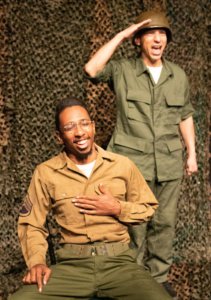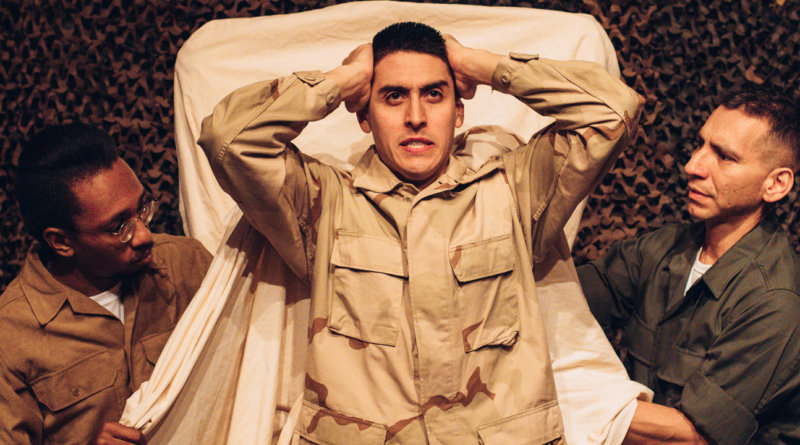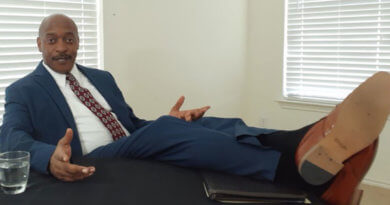Interview: Ana Olivo Funes, Director of ‘Elliot, A Soldier’s Fugue’
Beginning on Oct. 18, the Classic Theatre of San Antonio is presenting Elliot, A Soldier’s Fugue, the first play in the “Elliot Trilogy” that was written by Pulitzer-winning playwright Quiara Alegría Hudes.
The story focuses on three generations of Puerto Rican men who have all fought in (and been damaged by) war: Grandpop, who served in Korea; Pop, who did his time in Vietnam; and Elliot, who has just returned home to North Philadelphia with a leg injury sustained in Iraq.
The common thread connecting them is their memories of battle and how they manage to cope with them. The sole female in the cast is Ginny, Pop’s wife and mother of Elliot, who has war stories of her own, having met Pop as a nurse in Vietnam.
As Hudes’ title suggests, the piece is structured as a fugue — a contrapuntal compositional technique in two or more voices, built on a a theme that is introduced at the beginning and recurs frequently during the composition.
Elliot’s director, Ana Olivo Funes, realized that Hudes’ piece could be enhanced with the theatrical techniques that consistently fascinate her: the Suzuki Method and Viewpoints. She talked to ArtScene SA about how she integrated them into the upcoming performance.
What drew you to this particular material?
I just loved the language of the play. I loved the writing style. It’s very lyrical, almost like prose. I was drawn to it because I come from a military family, so I identified with it in that way as well. After reading it through a few more times, my training in Suzuki and Viewpoints gave me visions of what this play could be. I couldn’t see it any other way. And I knew it was something I wanted to bring to San Antonio that I hadn’t seen here yet.
Viewpoints was developed by dancers Anne Bogart and Tina Landau in the early 80s. They got influenced by seeing some modern dance choreography and the idea is that it’s very dynamic — as if you were seeing Cirque du Soleil. It’s very stylized, both rigid and fluid at the same time.

Where does Suziki come in?
The Suzuki methodology (developed by Tadashi Suziki) is outside-in as opposed to inside-out. When he came to see Western theater, he felt as if he was seeing a bunch of talking heads. It was very cerebral and very inside-out. Coming from Japan, where theater is very outside-in, very rigid, stylized movements, he felt like it stopped. He wanted to change it.
What’s beautiful about Suzuki is that there are no wasted moments. Every step and every gesture and every expression is meaningful. I think this play is such a great marriage of the two styles. If it was something that could be done in a movie, why not just make the movie? I want the experience to be purely theatrical, something you can’t film. You have to be there. It’s the energy that’s generated between the audience and the actors.
So how did you cast the actors with this radical new approach?
When I was auditioning actors, I knew this was the style I wanted to direct the show in. I didn’t do the usual audition process of “Read a monologue, thank you.” I did a lot of movement exercises with them. I wanted to see how well they took to the direction and that they could move. As it turns out, of the four cast members, two of them have dance backgrounds and one’s a martial artist. I got very lucky in that respect. As they told me often in rehearsal, I like to beat them up with theater.
It’s about getting out of your comfort zone. It’s looking at things in a way we haven’t traditionally done them before. But with this script, where you’re going in and out of time — first you’re in Vietnam, then you’re in the Korean war, then you’re in Iraq, then you’re in modern-day Philadelphia and looking back. Sometimes characters are narrating what the other characters are doing. To do that in a way that is coherent and gives the audience something to connect to, I feel like this staging actually helps communicate in a way that is beautiful. I hope it’s something that people will appreciate.
So what do you want San Antonio audiences to get out of this show?
In the play, you’ve got three generations of military men, and that’s common in today’s society. We’re dealing with the ramifications of PTSD and all these people who are veterans, and I think that’s what the playwright is trying to convey. They all have the nightmares and the feelings of trying to cope in society, post-war. When you see the show, you see how they all share a collective experience and how that becomes a part of who they are.
I want to pay homage to people from San Antonio. That’s where my family is from. It’s really meaningful for me to come and expose them to a type of theater…that’s my passion. The show is less about war than it is about the family.
Elliot, A Soldier’s Fugue plays Fridays and Saturdays at 8:00 p.m. and Sundays at 3:00 p.m., Oct. 18-27, at the Classic Theatre of San Antonio, 1924 Fredericksburg Road. Reservations can be made online or by calling (210) 589-8450.
Feature photo by Cate Creative (l-r): Steven J. Tugman, Adam Ochoa, Luis Garcia, Jr.




